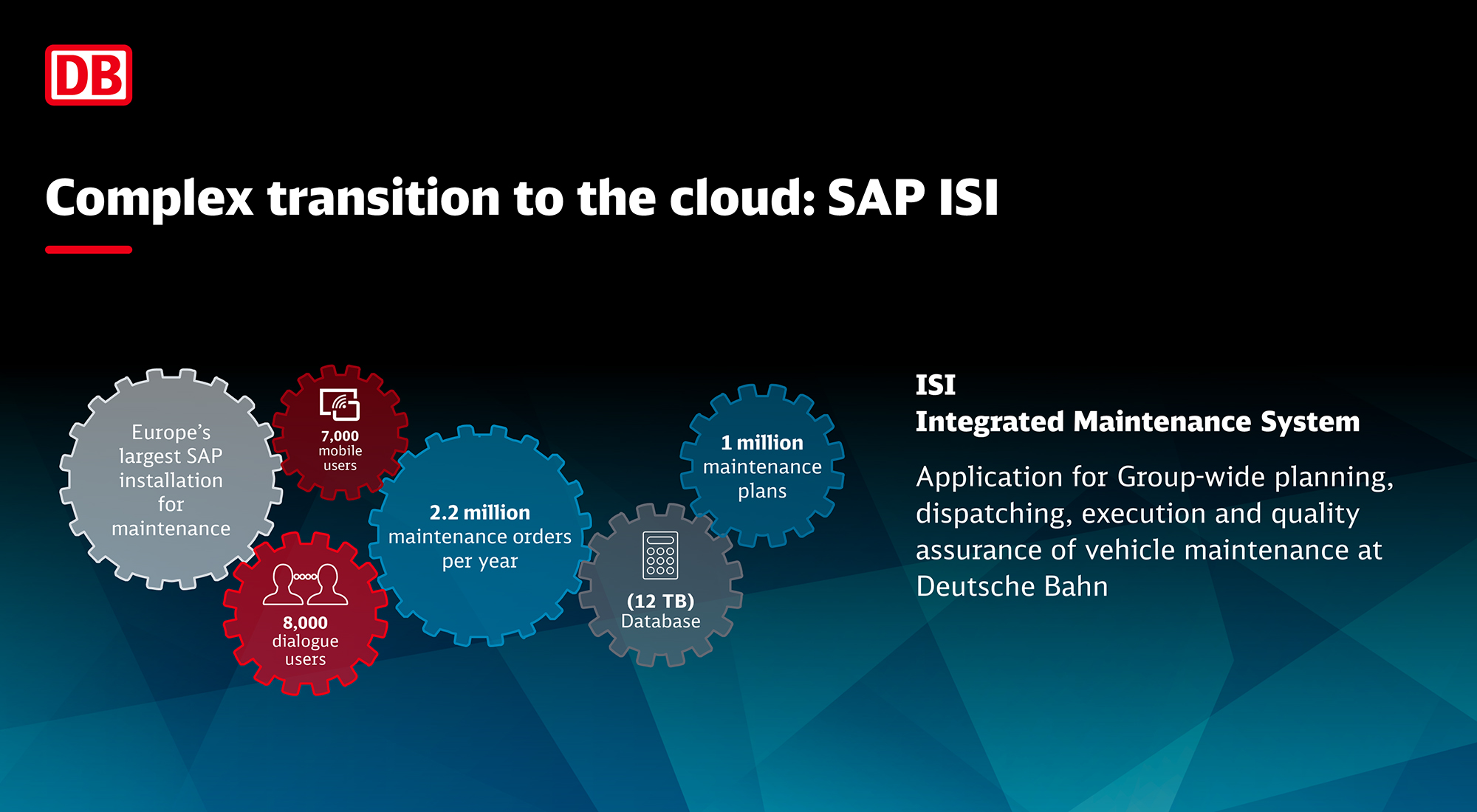Faster, more flexible, more efficient
Article: Deutsche Bahn’s SAP landscape is completely in the cloud
11/2020 – As part of the Cloud First strategy, Deutsche Bahn's SAP landscape was migrated completely to the DB Enterprise Cloud. We spoke with Daniel Kümmel, the migration project manager for SAP ISI, one of the largest SAP systems at Deutsche Bahn, and with his partners from DB Systel's SAP migration team, Thomas Wahlich and Dominik Heller, about the successful journey to the DB Enterprise Cloud.
Twenty-seven SAP application systems at Deutsche Bahn have been migrated to the cloud. How do you manage a project like that?DOMINIK HELLER: When DB Systel started planning the systematic cloud migration of Deutsche Bahn’s systems and applications at the beginning of 2017, we had little to nothing in the way of references and reports to help us with such an extensive migration. However, it was clear to us from the outset that we would not be able to migrate all the systems at once using a “big bang” approach but would have to migrate them to the cloud one at a time. In the third quarter of 2017, we started setting up the basic SAP structure in the cloud. At the same time, we were working on a plan to determine the order in which we would migrate the 27 SAP application systems. When doing this, we considered criteria such as complexity, technology life cycles, and the availability of resources on the customer side. It was particularly challenging to keep up with everyone who was involved in the project and to meet the fixed deadline. In the end, we started with the less complex applications in order to gain experience and achieve initial success quickly. This approach has proven to be the right one and we have carried out one of the largest SAP migrations in Europe with virtually no problems.
What were the key success factors for the project?DOMINIK HELLER: For the SAP systems – as well as other systems – we worked closely with the cloud provider AWS [editor’s note: Deutsche Bahn uses cloud solutions from both AWS and Microsoft Azure], who contributed their expertise and implemented necessary features for us. The way we organised ourselves for the migration and subsequent operation in the cloud was a major factor in our success. It is also important to understand that DB Systel has not simply opted for a new infrastructure in technical terms but has also changed its production model in the direction of agile methods with end-to-end operations. This means that teams now have the technical and AWS expertise they need to manage a system holistically and ensure that service levels are maintained. All migrations and training took place alongside normal business operations. Without the extraordinary commitment of all those involved – including on the customer side – we could not have succeeded.
“The way we organised ourselves for the migration and subsequent operation in the cloud was a major factor in our success."

Deutsche Bahn’s SAP cloud migration in figures
- 27 SAP applications, around 125 systems plus support systems such as SAP Content Server and output management solutions
- SAP HANA BW migration to the cloud
- Approximately 370 Amazon EC2 instances
- 260 terabytes of block storage
- Project duration: three years, including preparation
What are the advantages of DB Enterprise Cloud for the SAP ISI application system?DANIEL KÜMMEL: First and foremost, SAP ISI [see info box “About SAP ISI”] performs better in the DB Enterprise Cloud. For an application system that stores maintenance information for all Deutsche Bahn’s vehicles and processes it across companies, this is a key factor. Data can now be retrieved even faster and analyses are available within a few seconds. With the move to the cloud, further investments in hardware, which would otherwise have been necessary, were rendered obsolete. In some cases, ten-year-old components were replaced. Now, the system components are automatically kept up to date.
“Now, the system components are automatically kept up to date."

This also applies to the 20 other productive and non-productive systems that belong to the ISI universe. Another important effect is of course scalability. In the future, ISI will be able to grow technically in line with the requirements of our stakeholders, without us having to ask ourselves whether this investment is worthwhile in the long term. We can deploy additional virtual servers including computing power, storage and network within minutes. Last but not least, the cloud gives us a chance to breathe. We can now provide sandboxes and test systems for our many partners on request in an uncomplicated manner and try out new things quickly. The cloud makes us much more flexible.
About SAP ISI
The central IT application SAP ISI is the leading system for IT-supported maintenance of rail vehicles and buses in the Deutsche Bahn Group and the largest SAP installation for maintenance in Europe. More than 15,000 users plan, control, process and document the on-schedule implementation of vehicle maintenance tasks across companies. Offering auditability and quality assurance, SAP ISI provides a complete view of the condition of DB fleets and currently supplies 122 partner systems via 300 interfaces with operationally relevant information such as planned workshop visits, inspections (mileage-based and time-based) and operational readiness. ISI is also the central inventory database for vehicles and components of all DB AG multiple units, traction units, passenger carriages and freight wagons and provides reliable data for the Group-wide data lakes.In short, ISI helps to ensure that vehicles are available to customers on time.
How does SAP ISI run in the cloud?THOMAS WAHLICH: The DB Group’s decision to discontinue data centre operations was not related to our SAP systems but served to realign IT and create a flexible, future-proof IT infrastructure. ISI was already running very reliably and efficiently before the move to the cloud. We are currently carrying out optimisations in the cloud to improve cost-effectiveness. It will be some time before we are able to make full use of cloud-native services, but as the cloud environment is developing very dynamically, things may happen faster than we have seen so far.
“We are currently carrying out optimisations in the cloud to improve cost-effectiveness."

Where do you go from here and how will the SAP landscape evolve in the cloud?DOMINIK HELLER: Overall, the move to cloud computing has helped to reduce infrastructure costs by ten percent and has led to better efficiency in system operation, such as faster backup and recovery or additional opportunities for automation. In addition, it forms the basis for the forthcoming switch to new-generation software – with the prospect of further significant efficiency gains through process optimisation.
More information
- The cloud provider AWS has published a success story about the successful Deutsche Bahn SAP cloud migration.
- The market research and IT consultancy Information Service Group (ISG) has placed the Deutsche Bahn SAP cloud migration in the context of current market trends.



